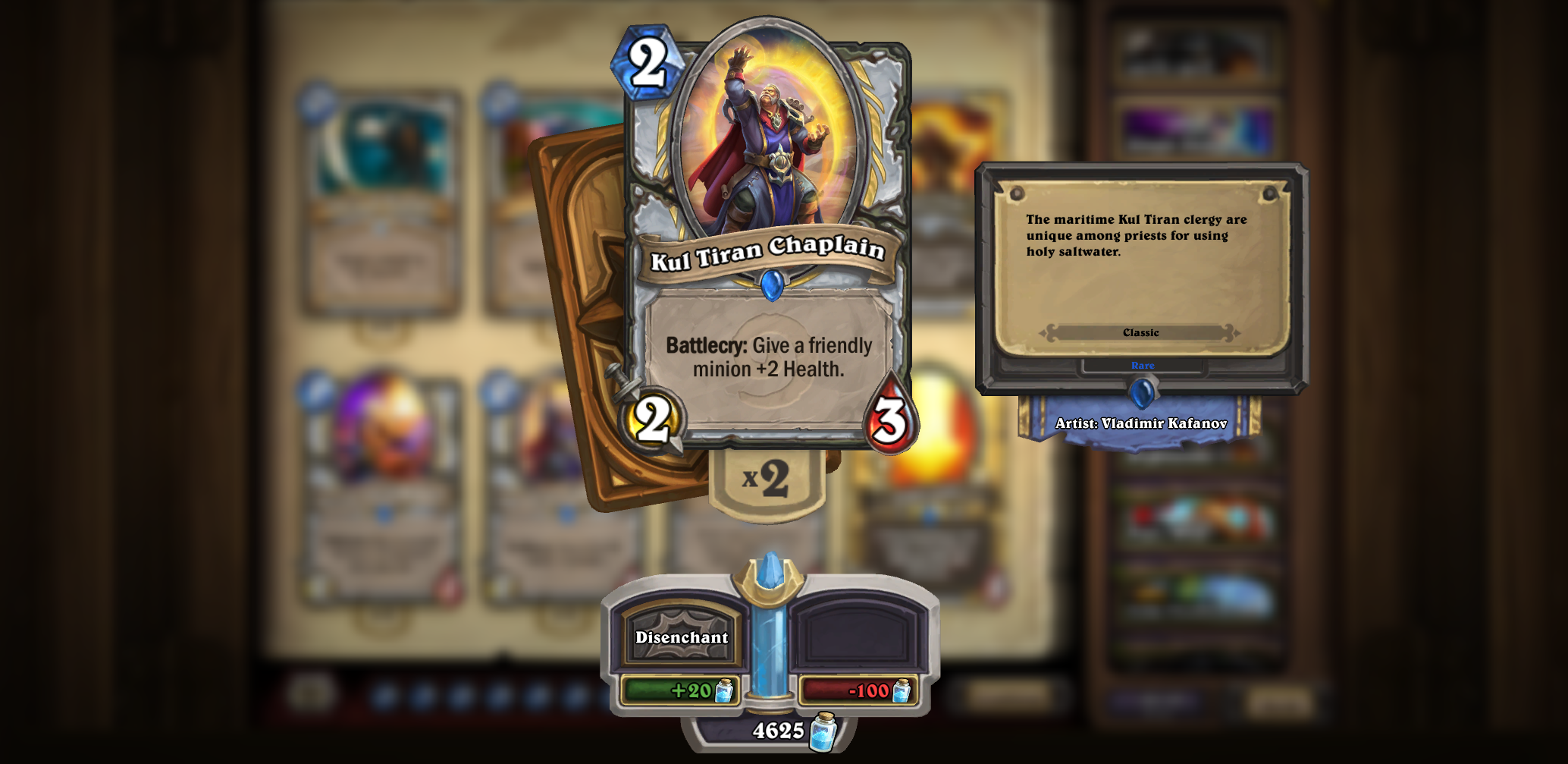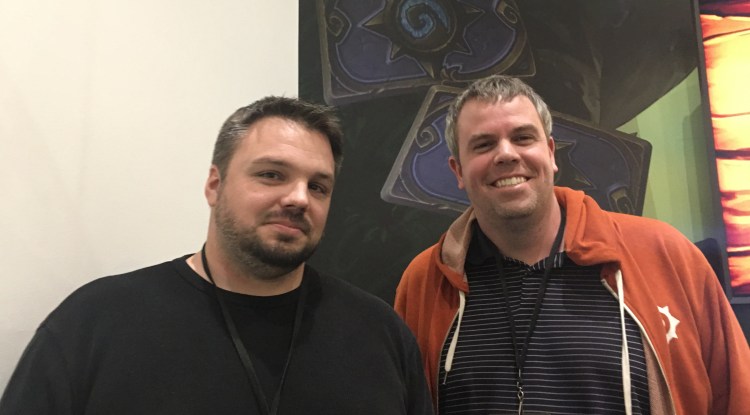Zephrys, retooling, and reloading
GamesBeat: How much work goes into teaching Zephrys how to deal with a new class? Note to readers here that Nathan is scratching his forehead.
Lee: A lot. Generally, there are times to invest in a card that’s worthwhile because it’s the tentpole of the set. Zephrys was that. Therefore the investment was worthwhile. We can’t do that for every card, obviously. In terms of the specific days, I’m not sure, but it was — making Zephrys work in general, making him pretty good — there are situations where he’s not perfect, but we’re generally happy with how he’s worked out. We’ve seen good positive feedback about him. He’s very useful. He also is a great counter card in many ways. I’m a big fan of counter cards. Personally, I think the game is a back-and-forth, and if you can’t interact with your opponent’s strategy, that’s not the most exciting gameplay. Zephrys definitely gives a window to interact with each other.
Lyon: Zephrys is looking at the board state to analyze what’s going on, so it does need to understand the mechanics of what’s on the board, but it doesn’t know anything about what’s in their hand. It doesn’t do anything with what’s in your hand either. It did need to learn a few mechanics. We taught it those to be successful.

Above: Kul Thiran Chaplain is one of Priest’s new cards as part of the class’s retooling.
GamesBeat: In hindsight, was it good to introduce all these new priest cards and retooling that class along with demon hunter, a new expansion, and teaching Zephrys all at once?
June 5th: The AI Audit in NYC
Join us next week in NYC to engage with top executive leaders, delving into strategies for auditing AI models to ensure fairness, optimal performance, and ethical compliance across diverse organizations. Secure your attendance for this exclusive invite-only event.
Lee: We can’t be beholden to something that exists in the game with what we want to do. It’s totally worth it. That’s more of a thing about, was Zephrys worth the time and effort? I think he was. It was cool. But we wouldn’t want to hamstring ourselves with future stuff because of something in the past like that. We’re trying to make the best fun things for our players. I wouldn’t want to not do the priest stuff or whatever the case may be.
GamesBeat: After the 2019 layoffs, there was talk from Activision Blizzard about hiring a bunch of new people for its team, for reinvesting into development. Then we get Battlegrounds and the rank refresh and the priest refresh and a new class. Is all of this the fruit of those extra people that have come in?
Lyons-Smith: I don’t know that there’s a one-to-one mapping there. I don’t remember all the talking points for the layoffs from a year ago, in terms of how resources were being shifted around. But generally, yes, dev was more of a focus at that point. It had to do with other games coming in the future as well, not just Hearthstone. At that point last year I don’t think we’d announced Overwatch 2 or Diablo IV, and as you can imagine, resources were going to those teams to build them up as well.
Lee: More of it is just, we’ve tried to get the team passionately engaged about making content and doing these different things. Strike teams is a way to do that. It’s been super effective. Our leadership team and the team in general — the game is at a point in its age where we have to try new things. We love this game and we want it to continue to be awesome and successful. Therefore, making sure we do cool things for players is the way forward. That’s been our big push. We hope players will be happy with it.
Tweaking the card economy
GamesBeat: The economy is going to get a huge change with the way you’re doing duplicate protection. Does this mean you’ll see more pack purchases, or does it mean people will be getting the cards they want?
Lee: Overall, if you add everything up, it’s cheaper, if you want to get everything. In general we want people to have useful options. There are some extreme examples that sound silly, but our game has so many players that it exists. It’s not small numbers that they exist. I’ll give you a couple of examples. There are players out there who, when they do their prepurchase — let’s say they get eight epics, and four of them are the same thing. They just massively miss out on economy. Even though you get value for dusting, you get a poorer return than if you got a card you would use. We are trying to shave off the probability ends that are really unfair and bad for people. There’s a famous video of Bolf Ramshield legendary, which you may have seen — how many copies does he get?
Lyon: It’s either five or seven. [It’s six — ed.]
Lee: Some guy opens a lot of packs and he gets [six] copies of the same legendary. This is before the legendary drop change. We want to eliminate scenarios like that across all rarities. We also just want the game to be more approachable and easy to get into. As an average player, when you open a card pack, if you get something new, we think that’s more fun and exciting and engaging. We talk about this average of 2.3 classes. We want people to have choice, and giving them cards that they don’t have in theory means they’re more likely to have things they want.
GamesBeat: Isn’t this also a huge move when it comes to the goodwill of your players? This is something people have asked for for a long time.
Lee: Hopefully. We hope players will be happy with it. We passionately think it’s the right thing to do for the game.
Ranking matters
GamesBeat: Why do the rank refresh now, adding tiers like what we had early in Hearthstone’s beta days?
Lee: For me personally, I think that — things like ranking systems, they generally want to be refreshed. It’s hard to determine a good time, but some period of time. Let’s say every two or three years or whatever the case may be. Change can be healthy. It can be good and engaging and fun. A lot of games out there, they refresh the systems after a certain period of time, and that’s where we’re at at the moment. Hearthstone’s rank system has done a lot of good for us. There’s definitely some elements that we want to improve on, and also add new flavor. Who knows? Maybe three years from now we’ll revamp the rank system again. Change, evolution, updating, and improving: It’s something we as a team very much believe in now and want. That’s how we’re looking at it in the future. It’s about giving players something new and exciting and engaging to do. Again, coming back to how easy the game is to get into financially, we’ve added first time rewards for all the rank floors. If you’re playing through the system, the first time you reach a rank floor, you’ll get a pretty generous reward, and those compound over time. It’s not just monthly. There are also special first time rewards.
GamesBeat: Do these new tiers take away what appears to be some of the work from laddering? For example, going from bronze to silver probably feels better than just going from 20 to 15.
Lee: Absolutely. Phrasing and terminology-wise — something we think about a lot, your rank — I can’t remember the exact numbers, but if you’re ranked 3, that’s the top 1 percent of Hearthstone. Rank 15 is probably top 75 percent. Rank 15 sounds pretty bad, but you’re actually really pretty good if you’re at rank 15 in reality. Part of the medal tiers, assigning the way they work, it’s really about our players feeling good about the rank. If you’re Gold 1, it sounds better than if you’re rank 13. We want players to feel better about where they are, but also we wanted the system to be — it’s more progressive. The idea is you should be moving forward a lot of the time until you reach the point you’re supposed to be at, and then it should be more of a challenge and you have to fight the way to get up there.
GamesBeat: A number of people — fans, media, and such — have said this has been the best year for Hearthstone: in Standard, the addition of Battlegrounds, the game feels really good in many different ways. From what you showed us today, it looks like you’re going to probably make it better next year, this next Standard year. Do you see the potential for that, and do you agree that this past year was Hearthstone’s best?
Lee: It’s hard to say. The first year was awesome, because everything was fresh and new. The reality is that we’re a little bit standing on the shoulders of giants that created the original game, Eric Dodds and Ben Brode and Derek Sakamoto and a bunch of other people. They were super-instrumental in making that happen. There was definitely a period of time in between then and now where the game could have maybe used a few more features and additions. We’re at a point now where we think that’s important for players. We want to give them new things to do. There’s been a few missteps in Year of the Dragon, definitely some things to learn from. We’re happy with a lot of what happened too. For Year of the Phoenix we hope we can deliver some awesome experiences. There’s something on the road map that we haven’t talked about yet, that we hope can deliver, that will be a cool surprise as well. We want there to be lots of stuff for players to do and engage with. We hope they’ll be happy.


